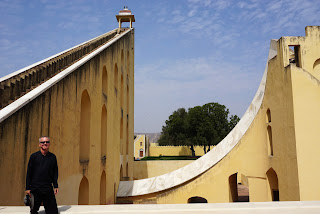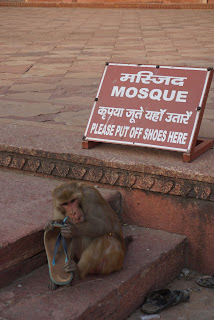March 6-7, 2016
March 6-7, 2016
Our organized tour is basically over. Now we start the multi-day journey back home. From Jaipur it is a 155-mile drive to New Delhi. Even with a toll road it is agonizingly slow. The highway disappears inside big towns and there is all kinds of non-motorized traffic. We stop at a roadside diner for lunch. We have the Thali plate which is a sample of several different vegetarian dishes. Yummy!
India will be a trip we will long remember. It is almost the exact opposite of our home in every way. To Westerners India is an enigma, a land of extreme contrasts, where high-tech lives next door to ancient. Travel through India is an assault on our senses and our modern sensibility. It is a kaleidoscope of cultures with colorful, painted Hindus, black burqa-clad Muslims, and Turbaned Sikhs wearing daggers. Where else can you see tigers, camels, elephants and cobras outside a zoo?
Our organized tour is basically over. Now we start the multi-day journey back home. From Jaipur it is a 155-mile drive to New Delhi. Even with a toll road it is agonizingly slow. The highway disappears inside big towns and there is all kinds of non-motorized traffic. We stop at a roadside diner for lunch. We have the Thali plate which is a sample of several different vegetarian dishes. Yummy!
We drop off one couple at the Delhi airport and the rest of us head to a hotel restaurant for a buffet dinner. Then it is back to the airport for our 1:35 am flight. Because we are heading into the wind it is a bit longer. And the flight is packed. I guess more people want to leave India than go. We can relate. India was a cool experience but the dirt and pollution are taking a toll. All of us have scratchy throats and sniffles. We are ready for some fresh Arizona air.
We get into JFK early, and since we carried-on and are ahead of the rush, we make it through Customs in record time. We are facing a very long layover, so we break down and pay the unwarranted ticket change fee to take the earlier flight to Phoenix. We are saving less than four hours but we still have a long way to go. Our American flight is a grueling six-hour completely-full flight. I feel like a sardine. I think we should have overnighted again in NYC. I am cursing our decision, but I shouldn’t really complain. We traveled to the other side of the world. Less than 100 years ago, this would have been a month long journey. How easily we lose perspective. After retrieving our car it is two-hour drive to Tucson. We are home!
We get into JFK early, and since we carried-on and are ahead of the rush, we make it through Customs in record time. We are facing a very long layover, so we break down and pay the unwarranted ticket change fee to take the earlier flight to Phoenix. We are saving less than four hours but we still have a long way to go. Our American flight is a grueling six-hour completely-full flight. I feel like a sardine. I think we should have overnighted again in NYC. I am cursing our decision, but I shouldn’t really complain. We traveled to the other side of the world. Less than 100 years ago, this would have been a month long journey. How easily we lose perspective. After retrieving our car it is two-hour drive to Tucson. We are home!
India will be a trip we will long remember. It is almost the exact opposite of our home in every way. To Westerners India is an enigma, a land of extreme contrasts, where high-tech lives next door to ancient. Travel through India is an assault on our senses and our modern sensibility. It is a kaleidoscope of cultures with colorful, painted Hindus, black burqa-clad Muslims, and Turbaned Sikhs wearing daggers. Where else can you see tigers, camels, elephants and cobras outside a zoo?































